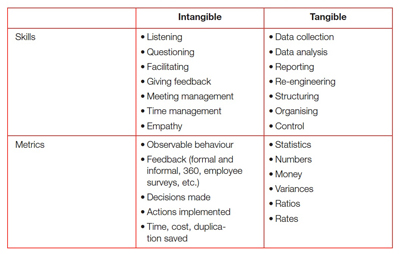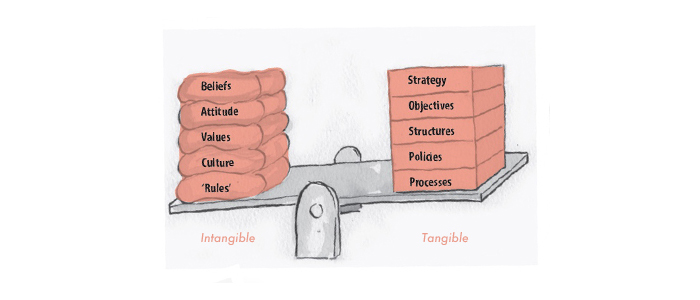Dealing with breakdowns in attitudes, values and behaviour in your organisation is not hard, but it does require skills such as listening, exploring, sharing, communicating. Here’s why, and how, you need to handle these situations before they turn into a crisis; it’s all about keeping the balance between your tangible and intangible skills.
As a leader and manager, you are accountable for the values and attitudes of your organisation, and for how they are expressed in the behaviour of the people who work for you: it’s called your organisation’s culture, and if you are not managing it with as much rigour as you employ to manage your finances, you are only doing half your job!
Different skills and different outcomes
It may help here if you recognise that it is possible to manage the things on the left hand end of the balance (shown in the diagram below) with as much rigour and specificity as you employ to manage the things at the right hand end. However, the skills and the metrics you use will be different.


Skills and metrics for managing intangible and tangible aspects of your organisation
Once you recognise that it is possible to manage the ‘intangible’ with as much rigour as the ‘tangible’, then it simply becomes a matter of assessing to what degree you have the necessary skills (if necessary, getting some training in these) and learning how to create the measurement systems you will need.
Keeping the balance
Once you have fully taken on board that managing your organisation properly requires that you manage both ends of the balance with equal rigour and skill, you will need to develop a feel for what needs handling at any given time, and for how to handle it. Ask yourself the question, “what does the business need right now?” The answer to this may be more subtle than you at first think, and tends to move from one end of the balance to the other and back again as situations arise and change.
Some issues are going to be clear cut. If the production line stops, then an engineering solution will probably be appropriate. If there’s a clear cut case of sexual harassment, then a disciplinary process followed by dismissal will be the right answer.
But if production is mysteriously down one quarter? Or the team seems to spend a lot of time making mistakes and blaming other people? The answer probably won’t lie at the right hand end of the balance. Yet it’s surprising to me how often production managers resort to setting the target higher in the belief this will resolve the problem. Or the team leader writes a new process and enforces it in the hope that the number of mistakes will fall.
In one of the most famous experiments in early management theory, Elton Mayo conducted a series of experiments at the Hawthorne factory of the Western Electric Company in Chicago. He isolated two groups of women workers and studied the effect on their productivity levels of changing factors such as lighting and working conditions.
He expected to see productivity levels decline as lighting or other conditions became progressively worse.
What he actually discovered surprised him: whatever the change in lighting or working conditions, even if they became worse, the productivity levels of the workers remained the same or even improved. From this, Mayo concluded that workers are best motivated by:
- Better communication between managers and workers (workers were consulted over the experiments and also had the opportunity to give feedback)
- Greater manager involvement in employees’ working lives (workers responded to the increased level of attention they were receiving)
- Working in groups or teams (workers did not previously regularly work in teams)
So very often the answer will lie in talking and listening to people and involving them in finding solutions that may not immediately be apparent. This is not a soft option, it’s a crucial leadership skill. You will find over time that your focus will naturally shift from one side to the other of the balance and back again. You’ll spend some time installing new systems and processes, then realise that you’ve lost the hearts and minds and have to do some talking and listening to bring people along with you. Or you’ll have a big push on the new company values, then have to bring people back to a clear focus on targets and results.
Of course it’s best if you learn to integrate the two ends and run them concurrently as far as possible. So alongside the introduction of your new production control system, instead of waiting for the outside consultants to finish their work and present the new system as a fait accompli, you include people in meetings to share their frustrations, implement the system and resolve problems throughout the installation.
The process of involving them in a structured way may in itself motivate the production to find that extra bit of speed, or the team to sort out its error rate by itself – and if the answer is to be found in increased targets or a bit of engineering wizardry, then they’ll find that out too.
Remember your job as the leader of a larger organisation is to be a custodian, not to find all the answers yourself (nor to hire outside consultants to supply state of the art solutions for you). The bees in the hive actually do know how to run the system. They may just need you to show interest and listen, then stand back and empower them to find their own answers.
How do you apply this mindset to your leadership?
- Recognise that you will usually assume that the issue, and its solution, lie somewhere on the right hand side of the balance.
- Recognise also that your instincts will usually be to focus on concrete things you can do to fix issues in your organisation.
- Start to hold back on supplying solutions to your teams, and create multiple platforms and structures – regular ideas meetings, problem-solving groups, one-to-one meetings with managers, for example – for them to have conversations among themselves to resolve problems and tweak the organisational culture as it grows. Without a space specifically to focus on this, all meetings tend naturally to gravitate towards operational issues.
- If you do involve outside experts, make sure they share your belief that the people affected don’t just need a say in the solution (the dreaded focus group), but actually have to be part of its creation and implementation.
- Get yourself and your key managers trained in questioning, listening, meeting facilitation and problem-solving skills, and use these skills consciously in everyday work.
- Use trained facilitators to get the best out of meetings and allow people to share and develop their ideas without being unconsciously closed down by task-focused meeting leaders.
- Recognise that doing it this way may take a little longer, but you’ll end up with engaged, motivated and solutions that last – and you won’t have had to come up with all the answers yourself!
Isn’t that better than short-term fixes and the stress of knowing that it’s all down to you at the end of the day?
This article is an extract from Kate Mercer’s book, A Buzz in the Building.
